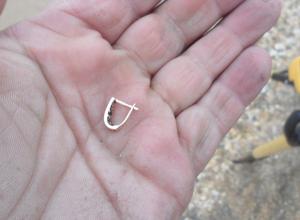State of aggregation when hydrogen sulfide is present. Chemistry lesson "Hydrogen sulfide. Sulfides" (9th grade). Mbou "Veresaevskaya Secondary School"
Purpose of the lesson: To consolidate students’ knowledge on the topic covered: allotropy of sulfur, physical and chemical properties, use of sulfur, occurrence in nature. Consider the properties of the sulfur compound - hydrogen sulfide and its salts. Consider the impact of hydrogen sulfide on the environment and human health. Consider the impact of hydrogen sulfide on the environment and human health. be able to draw up reaction equations in molecular form and from the point of view of redox processes. Moral and aesthetic education of students towards the environment.
“Then I heard (oh, marvel!), a foul smell, As if a rotten egg had broken, Or a quarantine guard was smoking chamois with a brazier. I, holding my nose, turned my face away...” Pushkin A.S.

Properties Hydrogen sulfide Chemical formula of the substance Type of chemical bond Physical state at no. Color Density in air Odor Occurrence in nature Solubility in water (dissociation equation) Obtained in the laboratory (reaction equation) Redox properties Acid-base properties Qualitative reaction to sulfide ions Physiological effect Environmental pollution Application

Molecular formula H 2 S oxidation state of sulfur (-2). Covalent polar bond The hydrogen sulfide molecule has an angular shape, so it is polar. Unlike water molecules, the hydrogen atoms in the molecule do not form strong hydrogen bonds, which is why hydrogen sulfide is a gas.


In a free state, it is found in the composition of volcanic gases, in many springs of volcanic areas, it is part of volcanic ash in a dissolved and partly in a free state, hydrogen sulfide is found in the Black Sea, starting from a depth of 200 meters or more. Hydrogen sulfide is found in a dissolved and partly free state in the Black Sea, starting from a depth of 200 meters or more. it is formed in small quantities wherever decomposition or decay of organic matter occurs: it is present in mineral muds formed at the bottom of shallow salt lakes; in the form of mixed substances of oil and gas. For some microorganisms (sulfur bacteria), hydrogen sulfide is not a poison, but a nutrient. Assimilating hydrogen sulfide, they release free sulfur. Such deposits form at the bottom of lakes on the northern coast of Africa, in Cyrenaica near the city of Benghazi.

Where does hydrogen sulfide come from in the Black Sea? Hydrogen sulfide is constantly formed at the bottom of the Black Sea during the interaction of sulfates dissolved in sea water with organic substances: Hydrogen sulfide is constantly formed at the bottom of the Black Sea during the interaction of sulfates dissolved in sea water with organic substances: CaSO 4 + CH 4 => CaS + CO 2 + 2H 2 O CaSO 4 + CH 4 => CaS + CO 2 + 2H 2 O CaS + H 2 O + CO 2 => CaCO 3 + H 2 S Sulfate-reducing bacteria participate in these reactions. Hydrogen sulfide does not reach the upper layers of water, since at a depth of about 150 m it encounters oxygen penetrating from above. At the same depth, sulfur bacteria live, which help oxidize hydrogen sulfide to sulfur: 2H 2 S + O 2 => 2H 2 O + 2S 2H 2 S + O 2 => 2H 2 O + 2S In recent years, due to the catastrophic pollution of the Black Sea, the upper The limit of hydrogen sulfide gradually rises, killing all living things on its way. The deadly border has already reached a depth of 40 m. CaS + CO 2 + 2H 2 O CaSO 4 + CH 4 => CaS + CO 2 + 2H 2 O CaS + H 2 O + CO 2 => CaCO 3 + H 2 S Sulfate-reducing bacteria participate in these reactions. Hydrogen sulfide does not reach the upper layers of water, since at a depth of about 150 m it encounters oxygen penetrating from above. At the same depth, sulfur bacteria live, which help oxidize hydrogen sulfide to sulfur: 2H 2 S + O 2 => 2H 2 O + 2S 2H 2 S + O 2 => 2H 2 O + 2S In recent years, due to the catastrophic pollution of the Black Sea, the upper The limit of hydrogen sulfide gradually rises, killing all living things on its way. The deadly border has already reached a depth of 40 m."> 

FeSO 4 + H 2 S FeS + H 2 SO 4 => FeSO 4 + H 2 S 2. By synthesis from sulfur and hydrogen: H 2 + S =>" title="Hydrogen sulfide can be obtained 1. In the laboratory, hydrogen sulfide obtained by reacting iron sulfide with hydrochloric or dilute sulfuric acid: FeS + H 2 SO 4 => FeSO 4 + H 2 S FeS + H 2 SO 4 => FeSO 4 + H 2 S 2. Synthesis from sulfur and hydrogen: H 2 + S =>" class="link_thumb"> 10 !} Hydrogen sulfide can be obtained 1. In the laboratory, hydrogen sulfide is obtained by reacting iron sulfide with hydrochloric or dilute sulfuric acids: FeS + H 2 SO 4 => FeSO 4 + H 2 S FeS + H 2 SO 4 => FeSO 4 + H 2 S 2. Synthesis from sulfur and hydrogen: H 2 + S => H 2 S H 2 + S => H 2 S 3. The interaction of aluminum sulfide with water aluminum with water (this reaction differs (this reaction differs in the purity of the resulting hydrogen sulfide): the purity of the resulting hydrogen sulfide): Al 2 S 3 +6H 2 O => 3H 2 S+2Al(OH) 3 FeSO 4 + H 2 S FeS + H 2 SO 4 => FeSO 4 + H 2 S 2. Synthesis from sulfur and hydrogen: H 2 + S =>"> FeSO 4 + H 2 S FeS + H 2 SO 4 => FeSO 4 + H 2 S 2. By synthesis from sulfur and hydrogen: H 2 + S => H 2 S H 2 + S => H 2 S 3. By the interaction of aluminum sulfide with water aluminum with water (this reaction is different (this reaction is different in purity obtained hydrogen sulfide): purity of the obtained hydrogen sulfide): Al 2 S 3 +6H 2 O => 3H 2 S+2Al(OH) 3"> FeSO 4 + H 2 S FeS + H 2 SO 4 => FeSO 4 + H 2 S 2. By synthesis from sulfur and hydrogen: H 2 + S =>" title="Hydrogen sulfide can be obtained 1. In the laboratory, hydrogen sulfide is obtained by reacting iron sulfide with hydrochloric or dilute sulfuric acids: FeS + H 2 SO 4 => FeSO 4 + H 2 S FeS + H 2 SO 4 => FeSO 4 + H 2 S 2. Synthesis from sulfur and hydrogen: H 2 + S =>"> title="Hydrogen sulfide can be obtained 1. In the laboratory, hydrogen sulfide is obtained by reacting iron sulfide with hydrochloric or dilute sulfuric acids: FeS + H 2 SO 4 => FeSO 4 + H 2 S FeS + H 2 SO 4 => FeSO 4 + H 2 S 2. Synthesis from sulfur and hydrogen: H 2 + S =>"> !}
Convenient way. Once at a lecture an experiment was demonstrated: melting sulfur in a test tube. Suddenly everyone smelled a disgusting smell. The lecture was disrupted. Once at a lecture an experiment was demonstrated: melting sulfur in a test tube. Suddenly everyone smelled a disgusting smell. The lecture was disrupted. Everything turned out to be simple: pieces of paraffin from the cork lid of the bottle in which the sulfur powder was stored fell into the test tube with sulfur. When heated, a mixture of paraffin and sulfur releases hydrogen sulfide: Everything turned out to be simple: pieces of paraffin from the cork lid of the bottle in which the sulfur powder was stored fell into the test tube with sulfur. When heated, a mixture of paraffin and sulfur releases hydrogen sulfide: C 20 H S => 21H 2 S + 20C C 20 H S => 21H 2 S + 20C The more the mixture is heated, the more the mixture is heated, the more active the gas is released. If heating is stopped, If heating is stopped, the reaction stops and hydrogen sulfide is not released. and hydrogen sulfide is not released. Therefore, the reaction is very convenient for producing hydrogen sulfide in educational laboratories. in teaching laboratories. 21H 2 S + 20C C 20 H 42 + 21S => 21H 2 S + 20C The more the mixture is heated, the more the mixture is heated, the more gas is released. If heating is stopped, If heating is stopped, the reaction stops and hydrogen sulfide is not released. and hydrogen sulfide is not released. Therefore, the reaction is very convenient for producing hydrogen sulfide in educational laboratories. in educational laboratories."> 
Physical properties of sulfur Hydrogen sulfide (hydrogen sulfide, hydrogen sulfide) is a colorless gas with the smell of rotten eggs and a sweetish taste. Poorly soluble in water, good in ethanol. Poisonous. Thermally unstable (at temperatures above 400 °C it decomposes into simple substances S and H2). Hydrogen sulfide is slightly soluble in water. At t = 20 º, 2.4 volumes of hydrogen sulfide are dissolved in one volume of water; this solution is called hydrogen sulfide water or weak hydrogen sulfide acid. Hydrogen sulfide (hydrogen sulphide, hydrogen sulfide) is a colorless gas with the smell of rotten eggs and a sweetish taste. Poorly soluble in water, good in ethanol. Poisonous. Thermally unstable (at temperatures above 400 °C it decomposes into simple substances S and H2). Hydrogen sulfide is slightly soluble in water. At t = 20 º, 2.4 volumes of hydrogen sulfide are dissolved in one volume of water; this solution is called hydrogen sulfide water or weak hydrogen sulfide acid. A solution of hydrogen sulfide in water is a very weak hydrogen sulfide acid. A solution of hydrogen sulfide in water is a very weak hydrogen sulfide acid.




Qualitative reaction to sulfide ion Laboratory experiment Laboratory experiment Pb(NO 3) 2 + Na 2 S PbS + 2NaNO 3 black precipitate black precipitate (Na 2 S + CuCl 2 CuS + 2HCl) black precipitate black precipitate write the complete ionic and short ionic equation

Hydrogen sulfide has the properties of a reducing agent. Hydrogen sulfide burns in air with a blue flame and produces sulfur dioxide or sulfur oxide (IV) 2H 2 S O 2 2H 2 O + 2S +4 O 2 2H 2 S O 2 2H 2 O + 2S +4 O 2 S -2 -6e S +4 Reducing agent O 2 +4e 2O -2 Oxidizing agent When there is a lack of oxygen, water and sulfur vapors are formed: When there is a lack of oxygen, water and sulfur vapors are formed: 2H 2 S -2 + O 2 2H 2 O + 2S 0 S -2 - 2e S 0 Reducing agent O 2 +4e 2O -2 Oxidizing agent O 2 +4e 2O -2 Oxidizing agent Hydrogen sulfide has the properties of a reducing agent: if a small amount of iodine water is added to a test tube with hydrogen sulfide, the solution will become discolored and sulfur H 2 S -2 will appear on the surface of the solution + I 0 2 S 0 + 2HI -1 S -2 -2e S 0 Reducing agent I e 2I -1 oxidizing agent I e 2I -1 oxidizing agent

Effect of hydrogen sulfide on the environment and human health Very toxic. Inhalation of air containing hydrogen sulfide causes dizziness, headache, nausea, and with significant concentrations leads to coma, convulsions, pulmonary edema and even death. At high concentrations, a single inhalation can cause instant death. At small concentrations, adaptation to the unpleasant smell of “rotten eggs” occurs quite quickly, and it ceases to be felt. A sweetish metallic taste appears in the mouth. At high concentrations, due to paralysis of the olfactory nerve, the smell of hydrogen sulfide is not felt. At high concentrations, due to paralysis of the olfactory nerve, the smell of hydrogen sulfide is not felt.

Application. Hydrogen sulfide is of limited use due to its toxicity. In analytical chemistry, hydrogen sulfide and hydrogen sulfide water are used as reagents for the precipitation of heavy metals, the sulfides of which are very slightly soluble. In medicine, as part of natural and artificial hydrogen sulfide baths, as well as in some mineral waters. Hydrogen sulfide is used to produce sulfuric acid, elemental sulfur, and sulfides. Used in organic synthesis to obtain thiophene and mercaptans. Colored sulfides serve as the basis for the manufacture of paints, including luminous ones. They are also used in analytical chemistry. Potassium, strontium and barium sulfides are used in tanning to remove wool from hides before tanning. Potassium, strontium and barium sulfides are used in tanning to remove wool from hides before tanning. In recent years, the possibility of using hydrogen sulfide accumulated in the depths of the Black Sea as energy (hydrogen sulfide energy) and chemical raw materials has been considered.


Hydrogen sulfide. Sulfides
Chemistry lesson, 9th grade
Prepared the presentation
chemistry teacher
highest qualification category
MBOU "Veresaevskaya Secondary School"
Levitskaya Ekaterina Nikolaevna

Updating of reference knowledge
- Write molecular and ionic equations for the reaction between solutions:
iron (II) sulfide and sulfuric acid
- What substance is formed as a result of the reaction?

Motivation for learning activities
Remember
what do you know about hydrogen sulfide

Hydrogen sulfide in nature, its physical properties. Obtaining hydrogen sulfide.

Sulfur Hyena
Yu. Kuznetsov “Secrets of the Black Sea”
Crimea was shaking in 1928,
And the sea reared up,
Emitting, to the horror of the people,
Fire pillars of brimstone.
It's all gone.
The foam is blowing again
But since then everything has been higher
everything is getting tighter
Twilight brimstone Gehenna
Approaches to the bottoms of ships.

Oxidizing agent or reducing agent?
H + 2 S 2-
S 2- - 2е→ S 0
S 2- - 6е→ S 4+
hydrogen sulfide has reducing properties,
because sulfur , included in its composition , has a minimum oxidation state -2 and in this case can only donate electrons

Filling out the table
Properties
Hydrogen sulfide
Substance formula
Type of chemical bond
Physical state at no.
Color
Lighter or heavier than air(confirm with calculations)
Smell
Solubility in water
Physiological action
Being in nature
Obtained in the laboratory
Chemical properties of hydrogen sulfide
Properties of an aqueous solution of hydrogen sulfide
Qualitative reaction to sulfide ions

Hydrogen sulfide combustion
Hydrogen sulfide is burning
in air with a blue flame, which produces
sulfur dioxide, or sulfur(IV) oxide and water .
And with a lack of oxygen, they form water vapor and sulfur .
Work in pairs:
Write down the equations for these reactions by arranging the coefficients using the electronic balance method)

Hydrogen sulfide - reducing agent
Combustion in air (blue flame):
2H + 2 S -2 + 3O 0 2 = 2S +4 O -2 2 + 2H + 2 O -2
S 2- - 6е→ S 4+
O 0 2 + 4 e = 2 O 2-
Combustion in the absence of oxygen:
2H + 2 S -2 + O 0 2 = 2S 0 + 2H + 2 O -2
S 2- - 2е→ S 0
O 0 2 + 4 e = 2 O 2-



Check yourself!
Na 2 S + CuCl 2 = CuS↓ + 2NaCl
2 Na + +S 2- + Cu 2+ +2Cl - = CuS↓ +2 Na + +2Cl -
S 2- + Cu 2+ = CuS↓
A black precipitate is formed - CuS -copper(II) sulfide

Independent work
Complete the task
according to the textbook:
to choose from
№ 2,3 page 70)


Live and learn!
TO EVERYONE:
1) Work through the material in paragraph 19
2) Fill in the remaining columns of the table
3) Problem No. 4, test tasks p.70
Creative task .
1) Using the Internet and additional literature, prepare a message or presentation on one of the topics:
“The influence of sulfur (IV) oxide on the human body”
"Acid Rain"
"Application of sulfur (IV) oxide"
2) Compose 3-5 test tasks based on the material studied.

To use presentation previews, create a Google account and log in to it: https://accounts.google.com
Slide captions:
“Then I heard (oh, marvel!), a foul smell, As if a rotten egg had broken, Or a quarantine guard was smoking chamois with a brazier. I, holding my nose, turned my face away...” Pushkin A.S.
FeS + H 2 SO 4 => FeSO 4 + H 2 S 2H + + S 2- ↔ H 2 S What substance is formed as a result of the reaction?
The Crimea shook in the year twenty-eight and the sea reared up, emitting, to the horror of the people, pillars of fiery sulfur. Everything is over. Foam is walking again, But since then everything is higher, everything is denser. The gloomy sulfur hyena approaches the bottoms of the ships. Yu. Kuznetsov “Secrets of the Black Sea”
Where does hydrogen sulfide come from in the Black Sea? Hydrogen sulfide is constantly formed at the bottom of the Black Sea during the interaction of sulfates dissolved in sea water with organic substances: CaSO 4 + CH 4 => CaS + CO 2 + 2H 2 O CaS + H 2 O + CO 2 => CaCO 3 + H 2 S B These reactions involve sulfate-reducing bacteria. Hydrogen sulfide does not reach the upper layers of water, since at a depth of about 150 m it encounters oxygen penetrating from above. At the same depth, sulfur bacteria live, helping to oxidize hydrogen sulfide to sulfur: 2H 2 S + O 2 => 2H 2 O + 2S In recent years, due to the catastrophic pollution of the Black Sea, the upper limit of hydrogen sulfide is gradually rising, killing all living things along the way. The deadly border has already reached a depth of 40 m.
Hydrogen sulfide Chemical formula of the substance Type of chemical bond Physical state at no. Color Density in air Odor Occurrence in nature Solubility in water (dissociation equation) Obtained in the laboratory (reaction equation) Oxidation-reduction properties Qualitative reaction to sulfide ion
molecular formula H 2 S oxidation state of sulfur (-2). Covalent polar bond The hydrogen sulfide molecule has an angular shape, so it is polar. Unlike water molecules, the hydrogen atoms in the molecule do not form strong hydrogen bonds, which is why hydrogen sulfide is a gas.
Being in nature
Found in nature in a free state, it is found in the composition of volcanic gases, in many springs of volcanic areas; it is part of volcanic ash in a dissolved and partly free state, hydrogen sulfide is found in the Black Sea, starting from a depth of 200 meters or more. it is formed in small quantities wherever decomposition or decay of organic matter occurs: it is present in mineral muds formed at the bottom of shallow salt lakes; in the form of mixed substances of oil and gas. For some microorganisms (sulfur bacteria), hydrogen sulfide is not a poison, but a nutrient. Assimilating hydrogen sulfide, they release free sulfur. Such deposits form at the bottom of lakes on the northern coast of Africa, in Cyrenaica near the city of Benghazi.
Air density determination
Determination of density by air D air -? M (Air) = 29 g/mol M (H 2 S) = 34 g/mol D air = 34:29 = 1.17 D air = 1.17 Conclusion: Hydrogen sulfide is slightly heavier than air
Hydrogen sulfide can be obtained 1. In the laboratory, hydrogen sulfide is obtained by reacting iron sulfide with hydrochloric or dilute sulfuric acids: FeS + H 2 SO 4 => FeSO 4 + H 2 S 2. Synthesis from sulfur and hydrogen: H 2 + S => H 2 S 3. The interaction of aluminum sulfide with water (this reaction is distinguished by the purity of the resulting hydrogen sulfide): Al 2 S 3 +6H 2 O => 3 H 2 S +2Al(OH) 3
Convenient way. Once at a lecture an experiment was demonstrated: melting sulfur in a test tube. Suddenly everyone smelled a disgusting smell. The lecture was disrupted. Everything turned out to be simple: pieces of paraffin from the cork lid of the bottle in which the sulfur powder was stored fell into the test tube with sulfur. When heated, a mixture of paraffin and sulfur releases hydrogen sulfide: C 20 H 42 + 21S => 21H 2 S + 20C The more the mixture is heated, the more active the gas is released. If heating is stopped, the reaction stops and hydrogen sulfide is not released. Therefore, the reaction is very convenient for producing hydrogen sulfide in educational laboratories.
Physical properties of sulfur Hydrogen sulfide (hydrogen sulfide, hydrogen sulfide) is a colorless gas with the smell of rotten eggs and a sweetish taste. Poorly soluble in water, well soluble in ethanol. Poisonous. Thermally unstable (at temperatures above 400 °C it decomposes into simple substances - S and H 2). Hydrogen sulfide is slightly soluble in water. At t = 20 º, 2.4 volumes of hydrogen sulfide are dissolved in one volume of water; this solution is called hydrogen sulfide water or weak hydrogen sulfide acid. A solution of hydrogen sulfide in water is a very weak hydrogen sulfide acid.
Dissociation of hydrosulfide acid: H 2 S → H + + HS - HS - ↔ H + + S 2- Dissociation in the second step practically does not occur, since it is a weak acid. It gives 2 types of salts: HS - (I)S 2- hydrosulfides sulfides
General properties of acids Interact with: - bases - basic and amphoteric oxides metals salts
Hydrogen sulfide acid reacts with alkalis in a neutralization reaction: H 2 S + NaOH → NaHS + H 2 O excess H 2 S + 2NaOH → Na 2 S + 2H 2 O excess NaHS - sodium hydrosulfide Na 2 S - sodium sulfide
Qualitative reaction to sulfide ion Pb (NO 3) 2 + Na 2 S → PbS ↓ + 2 NaNO 3 black precipitate (Na 2 S + CuCl 2 → CuS ↓ + 2 HCl) black precipitate
Hydrogen sulfide has the properties of a reducing agent. Hydrogen sulfide burns in air with a blue flame and produces sulfur dioxide or sulfur oxide (IV) 2 H 2 S -2 + 3 O 2 → 2 H 2 O + 2 S +4 O 2 S -2 -6е→ S +4 Reducing agent O 2 +4e → 2 O -2 Oxidizing agent When there is a lack of oxygen, water and sulfur vapors are formed: 2 H 2 S -2 + O 2 → 2 H 2 O + 2 S 0 S -2 - 2 e → S 0 Reducing agent O 2 +4е → 2 O -2 Oxidizing agent Hydrogen sulfide has the properties of a reducing agent: if a small amount of iodine water is added to a test tube with hydrogen sulfide, the solution will become discolored and sulfur will appear on the surface of the solution H 2 S -2 + I 0 2 → S 0 + 2 HI -1 S -2 - 2 e→ S 0 Reductant I 0 2 +2 e → 2 I -1 oxidizer
Effect of hydrogen sulfide on the environment and human health Very toxic. Inhalation of air containing hydrogen sulfide causes dizziness, headache, nausea, and with significant concentrations leads to coma, convulsions, pulmonary edema and even death. At high concentrations, a single inhalation can cause instant death. At small concentrations, adaptation to the unpleasant smell of “rotten eggs” occurs quite quickly, and it ceases to be felt. A sweetish metallic taste appears in the mouth
Application. Hydrogen sulfide is of limited use due to its toxicity. In analytical chemistry, hydrogen sulfide and hydrogen sulfide water are used as reagents for the precipitation of heavy metals, the sulfides of which are very slightly soluble. In medicine - as part of natural and artificial hydrogen sulfide baths, as well as in some mineral waters. Hydrogen sulfide is used to produce sulfuric acid, elemental sulfur, and sulfides. In recent years, the possibility of using hydrogen sulfide accumulated in the depths of the Black Sea as energy (hydrogen sulfide energy) and chemical raw materials has been considered.
Hydrogen sulfide prolongs youth
Homework: § 31 Thanks for the lesson.
Presentation on the topic "Hydrogen sulfide" in chemistry in powerpoint format. The presentation talks about the colorless gas hydrogen sulfide, its properties, production, application and toxicity. Author of the presentation: Zorin Sergey, Shakenov Serik, Yugay Dmitry, Ogay Artyom, 9th grade students.
Fragments from the presentation
Hydrogen sulfide, hydrogen sulfide (H2S) is a colorless gas with a pungent odor. - Chemical formula - H2S
- Rel. molecular mass - 34.082 a. eat.
- Molar mass - 34.082 g/mol
- Melting point - -82.30 °C
- Boiling point - -60.28 °C
- Density of the substance - 1.363 g/l g/cm3
- Solubility - 0.25 (40 °C) g/100 ml
- pKa - 6.89, 19±2
- State (standard condition) - colorless gas
- CAS number - 7782-79-8
Being in nature
Occurs naturally in petroleum, natural gas, volcanic gas and in hot springs.
Properties
Thermally unstable (at temperatures above 400 °C it decomposes into simple substances - S and H2), a poisonous gas heavier than air with an unpleasant odor of rotten eggs. The hydrogen sulfide molecule has an angular shape, so it is polar (μ = 0.34 10-29 C m). Unlike water molecules, hydrogen sulfide molecules do not form strong hydrogen bonds, which is why H2S is a gas. A saturated aqueous solution of H2S is hydrosulfide acid.
Receipt
- In the laboratory it is usually obtained by the action of dilute acids on sulfides: FeS + 2HCl = FeCl2 + H2S
- Or when adding water to aluminum sulfide: Al2S3 + H2O = 2Al(OH)3 + H2S (the reaction differs in the purity of the resulting hydrogen sulfide)
Application
- Hydrogen sulfide is of limited use due to its toxicity.
- In analytical chemistry, hydrogen sulfide and hydrogen sulfide water are used as a reagent for the precipitation of heavy metals, the sulfides of which are very poorly soluble
- In medicine - as part of hydrogen sulfide baths
- Hydrogen sulfide is used to produce sulfuric acid, elemental sulfur, sulfides
- Used in organic synthesis to obtain thiophene and mercaptans
- In recent years, the possibility of using hydrogen sulfide accumulated in the depths of the Black Sea as an energy and chemical raw material has been considered.
Toxicology
- Very toxic. At high concentrations, a single inhalation can cause instant death. At small concentrations, adaptation to the unpleasant smell of “rotten eggs” occurs quite quickly, and it ceases to be felt. A sweetish metallic taste appears in the mouth
- At high concentrations it is odorless.
Latest site materials
Psychology

Why does a woman dream about meat: raw, without blood, fresh, boiled, fried
Why do you dream of eating raw meat? You need to look into the dream book, it will give an accurate description of such a dream. This could be mental anxiety, an upcoming illness, or great luck. Remember the details of the dream. They are key to the interpretation of sleep. See
Family

Why do you dream about a lot of chickens?
A small chick is a protective magical symbol, so you need to find out why a particular dreamer dreams of chickens. Often, a bird seen in a dream represents some kind of beacon that helps to correctly and timely assess the surrounding situation.
Development up to a year

“Dream Interpretation of Earrings dreamed of why Earrings are seen in a dream
Earrings are a paired symbol. Why do you dream about earrings? What you see promises good news, an offer regarding a new job or a profitable marriage. What events await the dreamer if he found, lost or bought jewelry - a detailed description in our article. Good to know
Diseases

Interpretation of the dream garage in dream books Dreaming of looking for a place for a garage
Modern family dream book according to Freud: A dream about a garage is a sign of profit, good news Detailed universal dream book: A garage with a white gate - everything will be great. And even though a stream of minor troubles will fall on you in the coming days, you will honor
Pregnancy and childbirth

Why do you dream about raw kebab?
All cat owners know very well how their furry pets while away the days: they take a nap, eat, take a nap again, eat and go back to sleep. Yes, one can only envy such a pleasant pastime and instant falling asleep. Why do cats sleep so much and
Child nutrition

Kawaii chan. What is "kawaii"? Meaning of the word. Perception in Japan
Before increasing your own Kawaii quality, you should figure out what kind of Kawaii this is. He came to us from “neighboring” Japan and is already beginning to cling tightly. Bourgeois magazines write that his homeland is Shibuya, the central district of Tokyo, the Mecca of Japan
